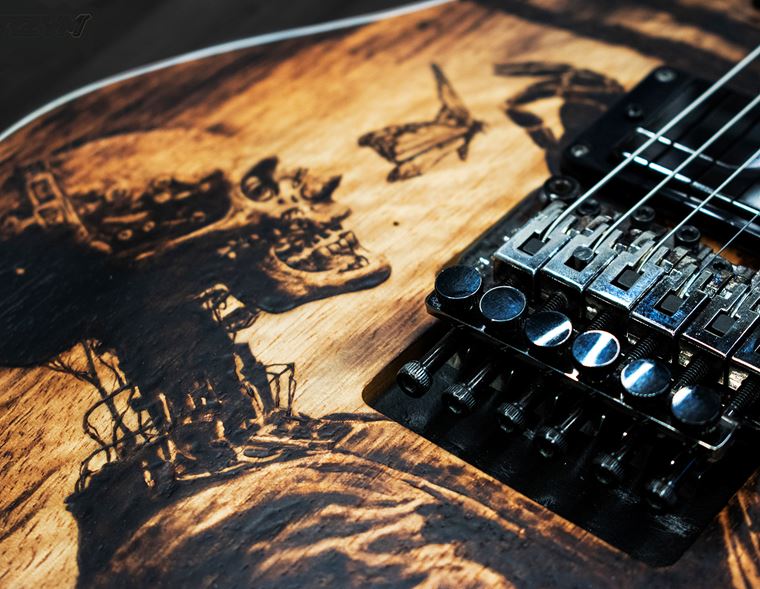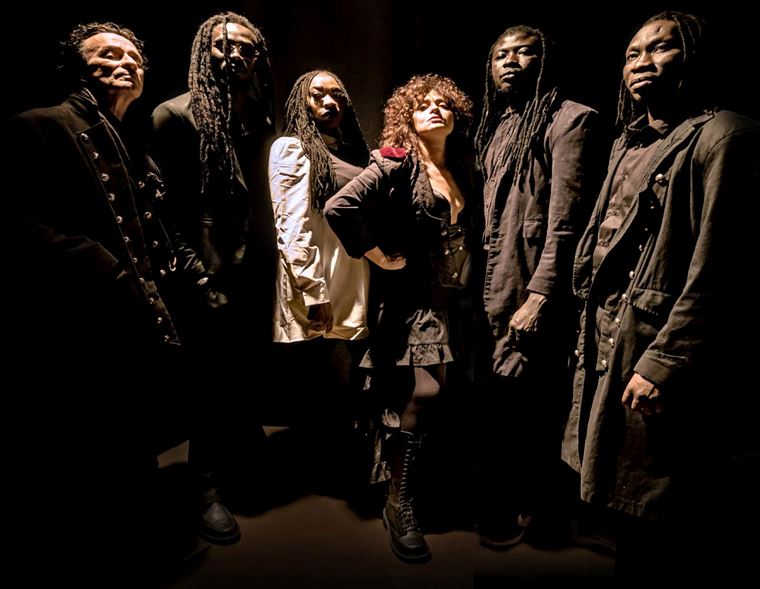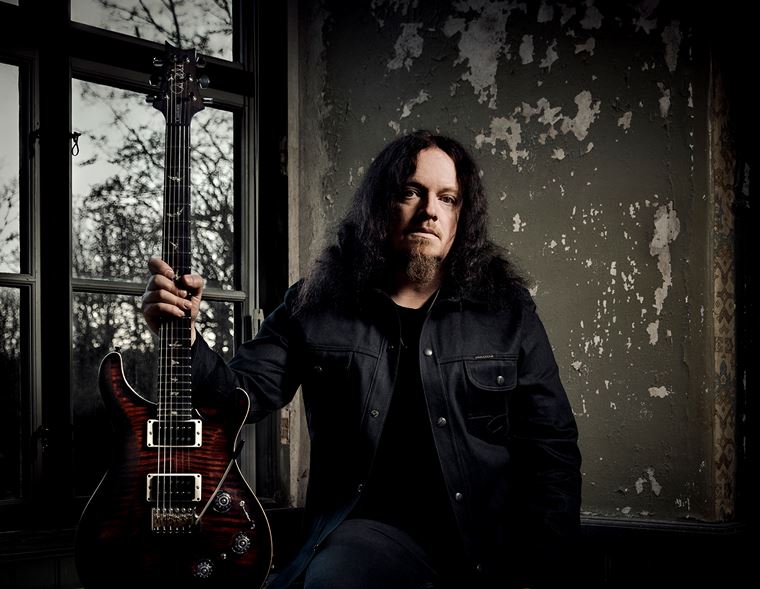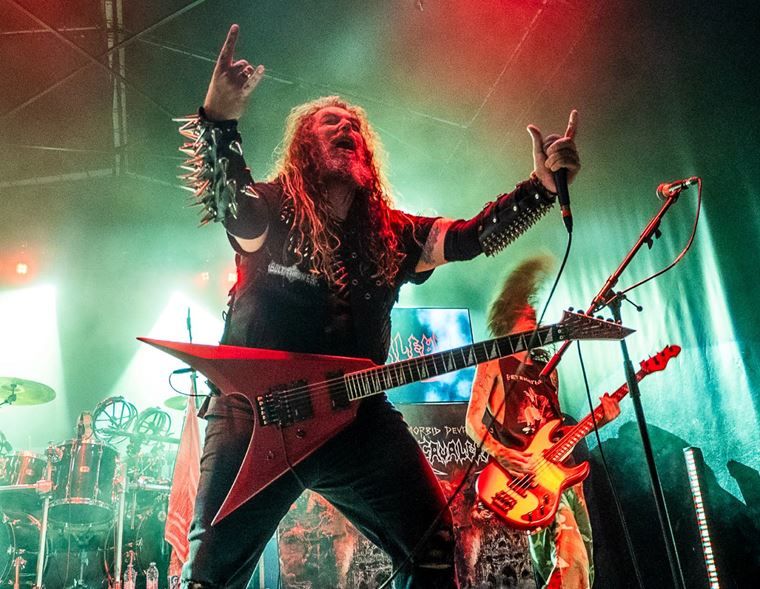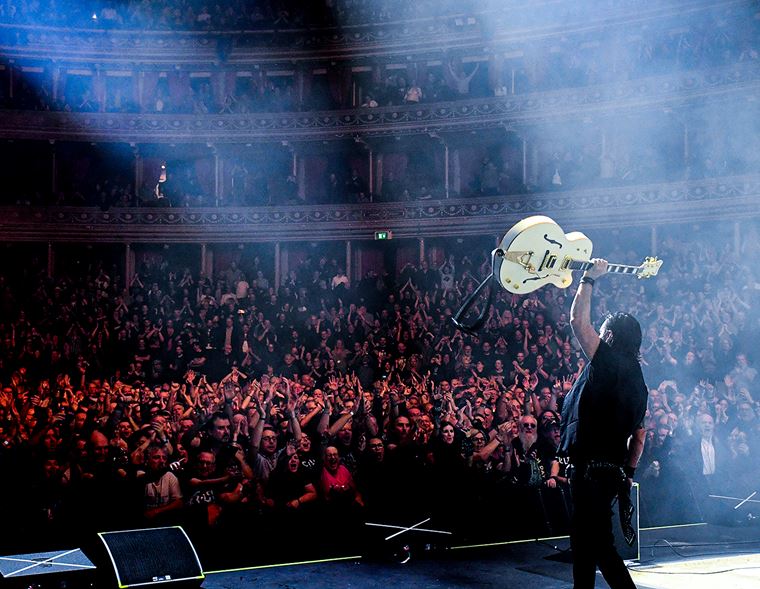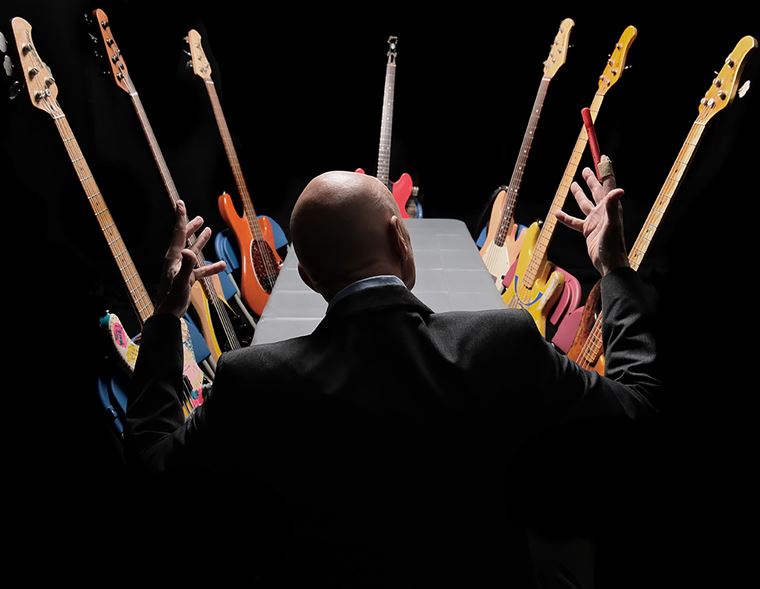GARY NUMAN's Steve Harris: Skirts, Lippy and Playing the Albert Hall with a £70 Guitar!
Gary Numan is an icon of darkly epic, electronically infused rock music. For over 40 years, this synth pioneer has defined and redefined the landscape of industrial rock, inspiring the likes of Trent Reznor and Beck in the process.
The last five or six years have been a real golden period for Numan, with 2017’s Savage record reaching number 2 in the UK album charts. He’s been riding high ever since, touring the world a number of times and releasing the similarly acclaimed Intruder album.
A fun curveball was thrown earlier this year when Numan announced a UK-wide acoustic tour, the first such tour he’s ever conducted. For somebody hailed as the Godfather of Synth-rock, this is not what anybody expected, but the ensuing shows proved to be a massive success, with old songs and newer numbers rubbing shoulders in some quite radically altered ways.
At Numan’s side throughout all of this since the mid 90s is Steve Harris, his guitarist. Steve is a familiar sight to all Numan fans, with his tall frame and distinctly alien-sounding guitar tones framing and punching through Gary’s epic synths. I’ve long-since wanted to chat with Steve, to see what life is like from his perspective, and to find out more about how he got into the band. We don’t often get to hear from Steve, so this was a special opportunity to get a unique, inside take of life in Gary’s band.
I've interviewed Gary before, around the time of Savage's release, but I'd not yet spoken to Steve. The time felt right to reach out!
Happily, Steve was happy to talk to me after the acoustic tour concluded, and we had ourselves a nice long Zoom chat in November, discussing everything from fuzz pedals to pawn shop Hohners. We talk about his relationship with Gary, how he handles being on tour, and the importance of recognising the underdog.
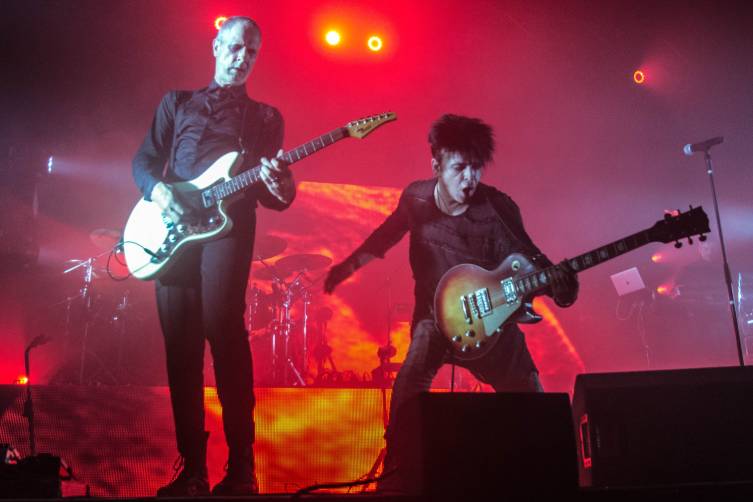
(Photo: Will Wilson)
Contents
Early Days: From Jesus Christ Superstar to Gary Numan
Steve’s Machines: Pedals & Amps
Touring Life, and 20 Years Knowing Gary Numan
Theatricality and Putting on a Show
Early Days: From Jesus Christ Superstar to Gary Numan
Guitarguitar: For the sake of our narrative today, Steve, could you fill us in on your background as a musician, and how you got in touch with Gary Numan?
Steve Harris: It’s all a bit hazy for me, really. I had a pretty directionless youth. I just didn’t have a clue what I was doing! I worked in a fairground, I worked cleaning toilets, then I got a job with the local council but I used to sit in the office, look at people and hate them (laughs)! I was just thinking ‘You fucking love this, don’t you?’ The hierarchy and everything, just awful! But I’d started playing: in Portsmouth, where I grew up, there was a great community there and one guy especially: we’d go round in the evening and there’d be up to six guitar players sitting around there, smoking, putting on tunes and passing the guitar around. I was by far the youngest and I learned from everybody there, just what was making people go ‘ooh’ and ‘aah’, that sort of thing.
I started playing in bands down there - I was playing in a country band for a while - and a guitar player in a studio I went to broke his wrist. He was in a blues band and they asked me if I wanted to do it. It was so far over my head but I just said yes anyway. That was my first tour, and from that, the MD (musical director) in the studio did musicals, so I got the offer of doing Jesus Christ Superstar for 5 weeks! I only had three weeks of annual leave left, so I just handed my notice in! (laughs) That was that! Off I went!
I couldn’t read music either, but one of my mum and dad’s record collection was the original studio version of Jesus Christ Superstar, with Ian Gillen as Jesus, Murray Head, all these people. I absolutely loved that album, so I kinda knew it. From there I did lots of pantomimes & things in the pit orchestra. Through doing those, I met a drummer who was playing in a fairly well-renowned band called FBI in London. Their guitar player was moving on so I got a job with them and moved up to London.
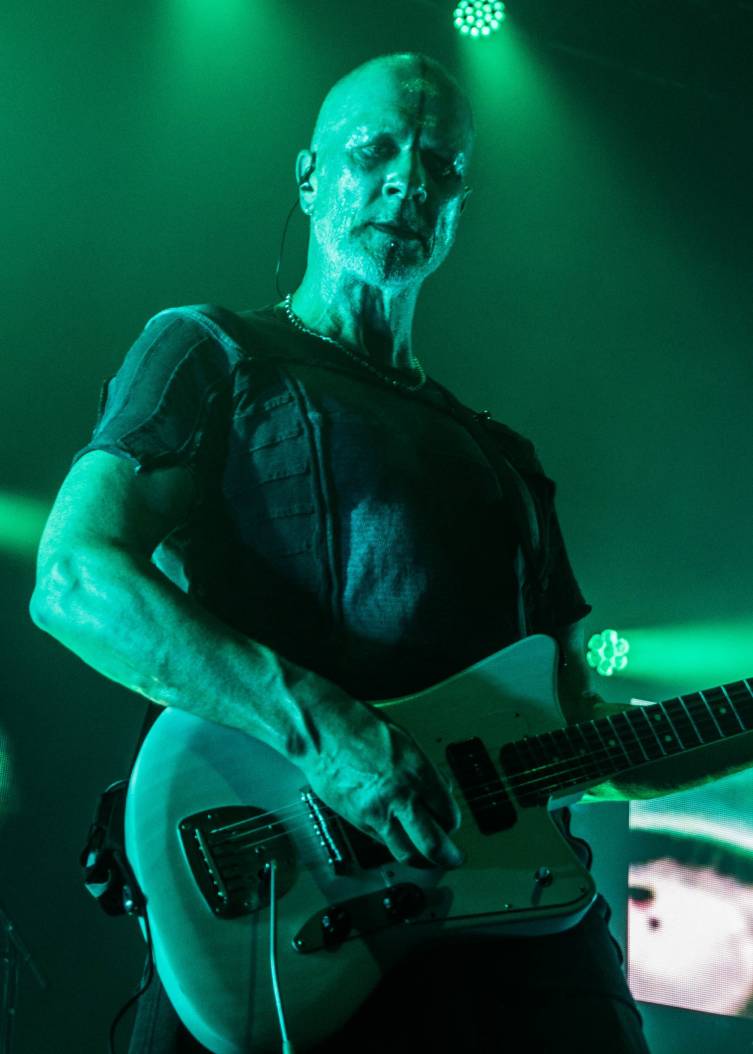
(Photo: Will Wilson)
The London scene at the time was rife: I mean, I loved down the road from Darren Mooney, the drummer in Primal Scream. He was playing in a covers band. All these people, apart from their prestige gigs, they’re all hammering away in pubs at night, you know? That’s where I met Dave Brooks from Gary’s band. And Rob Harris - the guitar player before me - he got the job with Jamiroquai, and so Dave said to me “Do you want to come along and step in at a rehearsal?”
So that was how I met Gary. I went there, absolutely shitting myself just because of the enigma that is ‘Gary Numan’ and we went straight into rehearsal. He kind of - well, it sounds like I’m bigging myself up - but he’s a great judge of character, he’s always had really lovely people around him. It doesn’t matter to him whether you’ve got a name for yourself, it’s just how good are you, and how easy are you to get along with. I didn’t know it, but I was rehearsing for the tour from day one!
GG: Wow! Now, is that sort of 1997-8 kind of time?
SH: I think it was 97?
GG: So, you’ve been with Gary mostly since then, is that right?
SH: Well I had a lot of time off because I played with a couple of other bands. I played with a band called Archive, and I did about 5 albums with them. Absolutely huge in mainland Europe, like we were headlining festivals. One festival we did was My Chemical Romance, then Deftones, then us with an orchestra.
GG: Oh wow, that’s huge!
SH: Yeah (laughs) it was a big one in Paris, yeah.
GG: Holy shit! Apologies for not knowing that: even when I was researching, the name ‘Archive’ didn’t really jump out at me. It must be that British people aren’t so clued up on it, eh?
SH: They couldn’t get arrested over here! Funnily enough, I stopped playing with them around 2013 to do full time with Gary. They were ever-evolving, it was more like a collective. They’ve always come from a more electronic, DJ, sampling background and they were getting much more into that. The two guys singing both played the guitar, so there was not an awful lot of point for me to be there. Thank the lord Gary welcomed me back to the fold! I owe Gary a huge debt of gratitude.
GG: Well, you’re obviously the right man for the job!
SH: Maybe it’s better the devil you know! (laughs)
GG: That could be more true than you might think, haha! So, you mentioned how Archive is largely an electronic band. This is true of much of Gary’s music as well. As much as it’s presented as a live rock band with guitars, bass and an acoustic drum kit etc, in terms of the listening experience on the record, it’s very much electronic music with guitars and things on it. That’s not your average gig as a guitar player, and you’ve recorded on a number of his records, from Pure onwards, if I’m not mistaken?
SH: I think it’s before then, but we’re both in the same boat here a bit hazy with dates! For me, this whole journey is about tomorrow, it really is. I’ve got a little cabin at the end of the garden and there’s a corner of it all stacked up with photos, people have done paintings of me, and there’s a few gold discs and things like that…I would NEVER put them on the wall! It’s just not about that. The best thing in the world is: I’m in the band! I don’t need to show people; I don’t need to remind myself, but it’s because I am! That’s fantastic, but if I’m shit tomorrow, I will feel awful. I won’t think ‘Well, I’ve been great all this time’.
Anyway, that’s why I don’t know specific dates: I’m always working for tomorrow, you know?
GG: Sure, that’s a good answer! And that old cliche ‘you’re only as good as your last gig’ applies there. It’s a cliche because it’s true, right?
SH: Absolutely true, yeah. Getting back to what you were saying about the electronic side of things, I’ve smarted a little bit in the past where I’ve gone into the studio and of course the mix that I have is Yours Truly and a little bit of tinkling in the background (laughs), you know? Then of course there’s a feed from the pedalboard and everything, and then there’s the dry feed. Ade Fenton the producer, he puts all his toys onto that, and sometimes - for the betterment of the track - it ends up sounding like white noise! I have to be told what is guitar, sometimes.
GG: Even though you played it!
SH: Yeah! But more recently, the last album (Intruder), it’s fairly bold. I was much more pleased with the mix on that. But I sat down and watched Gary on Top of the Pops. It’s his name on the ticket, it’s his name above the door. I’m not gonna start complaining about getting up in the mix.
GG: That’s really interesting about how Ade gets his hands on your guitar parts, as of course ultimately he’s gonna do, given that he’s producing. My take on this one is: if you’re playing an old-school boogie-woogie blues tune and you’ve got your vintage Strat and your Tweed amp, there's an expectation there of a sound. Guitar players are way more conservative, generally speaking, than we want to let on. The oeuvre that you’re working in isn’t really like that, because it's forward thinking, much like your attitude as you described it a second ago. It’s mainly about futuristic sounds that aren’t necessarily indicative of guitars in themselves, even though guitars are creating them. Do you approach it like: there’s a certain space and frequency, how do you fill it? Or does Gary want you to do a certain thing? How does your performance actually percolate?
SH: It’s very much that. Over the years, I’ve kindred of painted myself into a corner when it comes to what I’m known for doing. It’s very effected stuff. Sometimes I used to have the Eventide H9 blazing away, and then I’d have an octaver on that, then I’d swamp it in reverb and always cock the wah and filter it backwards and forwards. And maybe I might be holding a chord and then sliding octaves. By the time you do that, and it’s in the mix, you’d never know it was a guitar.
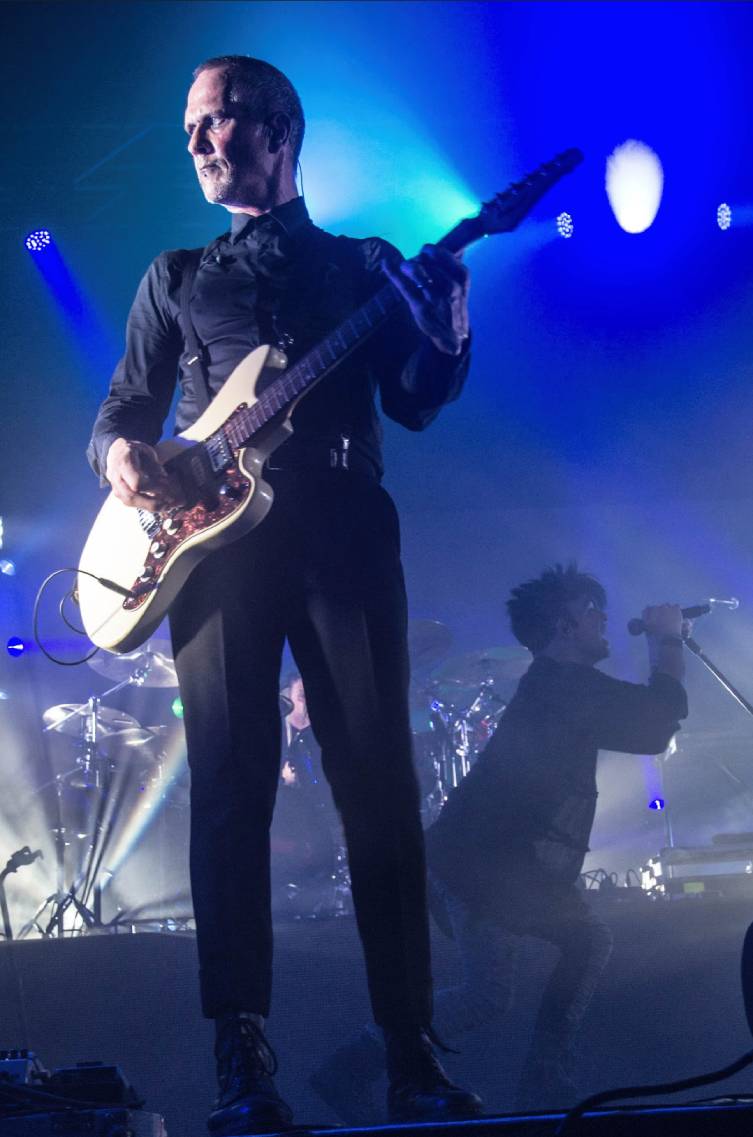
(Photo: Will Wilson)
I’m really proud of that part of my playing to tell you the truth, because there’s no ego involved with any of it. I’ve just done a couple of sessions remotely for a couple of people, and they’ve both been fairly heavy, so I’ll double the riff, then do a couple of bits and pieces to slightly change the cadence of the sound. Then once I’ve done the meat and potatoes, it’s into the Eventide and I get the most ridiculous little ice cream van sound and just fit it in there. For me, that’s it. Send! And I’m really happy, mainly because of that sound. You’d never have that in a tune like that! It works every time for me. I love thinking that way. People want the doubled riff, but it’s the other bit - the bit that doesn’t sound like a guitar - that's sort of my unique selling point. People can throw anything at me and I’ll try as hard as I can.
Steve’s Machines: Pedals & Amps
GG: I love that! I’m interested in specifics - and it’s up to you of course how much you feel like sharing - about your sound. I wouldn’t mind knowing what’s on your pedalboard, basically haha! And also, are you going into an amp normally, or are you DI’ing?
SH: Well I’ve tried so many setups because I’m always reading about things, checking out different equipment and stuff. I took the big leap into Axe-FX maybe about six or seven years ago. It wasn't instant, but it didn’t take long for me to think: what are you doing? I love having knobs when I’m playing away, if the sound just needs a little bit more. A little tweak there, you know? So I’ve had the Axe-FX, I’ve got an HX Stomp, and it feels really dishonest when you’re getting it all from a little box like that.
At the moment, the pedalboard that I’ve just dismantled does have the HX Stomp on it, but I always have an amp and cab. I just can’t get my head round the FRFR, so I’d always have to have something on stage: even when I use in-ear monitors, I have one in, one out. People try to build ambience into their in-ear monitors, but just pop one out: there it is! (laughs)
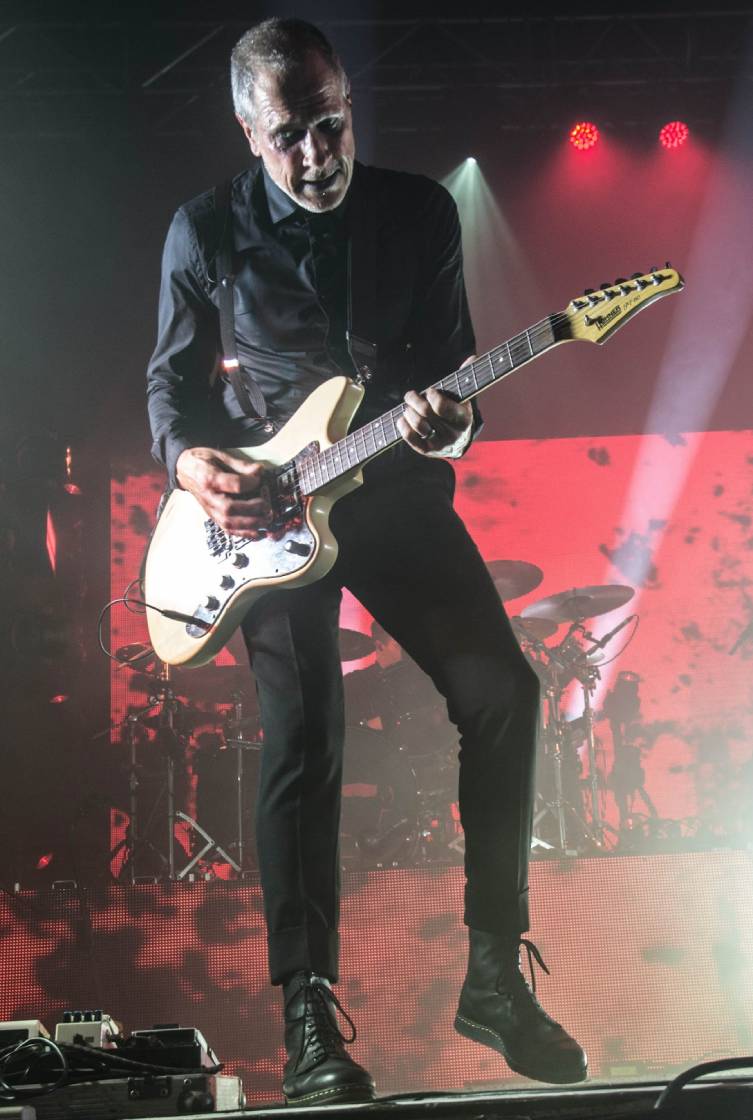
(Photo: Will Wilson)
So, I’ve got a buffer at the front and the end and then I’ve started going into wah first - unless I’ve got a fuzz, then I’ll go to fuzz first - and then into a tuner, because a lot of tuners have got buffers in them and they’ll push the front of your wah pedal and your fuzz as well. Then I’ve got this secret for the wall of sound which I can’t use live because it’s uncontrollable, but it’s a pedal called a Sustain Punch Creamy Dreamer. I’ve had it for maybe 15 years. It’s one of these ones when you open the back of it. It’s covered in gloop and I think it was something to do with your man from Smashing Pumpkins, his Russian Big Muff. That’s what this guy has tried to capture in this pedal and it really is uncontrollable, but it’s great!
So yeah, I go into that, and then drives. Before I came onto this interview, I was looking for drive pedals. It’s a never ending heartache, it really is! I’ve got a Boogie V-Twin pedal. I used the Rectifier sound on the HX Stomp as a dirt pedal. I used to have a 5150 - the distortion out of that is amazing - but then of course the whole trend was to downsize and I got rid of it. Wish I had it back now! At the moment I’ve got a Soldano SLO pedal which is pretty pokey. I’ll use three flavours of distortion: a verse, a chorus and then if there’s any sort of lead passage, I use something else for that as well.
GG: Would you tend to have each of those pedals set to ten and just have them on and off one at a time, or do you stack the gains together?
SH: I’ve stacked the Earthquaker Plumes into the Soldano before. I quite like - just because of the logistics of dancing around like a loony on stage - you don't wanna be doing a double tap, so I try to keep it separate. I don;t know if the audience would particularly know if I had one going into another!
So I come out of that, and I’ve always got an octave divider of some sort. My go to is the Electro-Harmonix Epitome, which has a reverb, a chorus and a Micro Pog in it. Then the H9, which has been a friend to me, that one has. There are some songs I can’t do without it!
As far as delay goes, I’ve tried loads and loads, I’ve got the BOSS RE-202 which is great for the studio, but DD-7 all the time! It’s got the knobs on it and the knobs are where you left them, you know? I’ve got a tap tempo plugged into that, and I go into a Strymon Flint and the way I’ve got it set up, I’ve got the big ambient reverbs, but I can always flip on the tremolo at the end. On one tour, I had a DD-6 on the end, just for the very end of the set. You turn the repeats all the way up and go (makes atonal guitar noise, followed by lots of repeats), you do the mic drop and off you go! (laughs)
GG: It has to be done! That’s really interesting: there’s this trend with the last three or four people I’ve spoken to for work, all quite individual payers, and they all prefer the BOSS DD Digital Delay pedals over the fancy stuff they were using three or four years before. It seems that you can’t beat them for their functionality. It’s also hard to find a delay pedal that does that trick when you set it really fast and it goes Br-r-r-r-r-r-r but then you can turn it off and the tails stop! Maybe it’s more creative because it’s not trying hard to be 12 different things?
SH: I keep on getting drawn into that trap, drawn in and then I buy more stuff and instantly think: how am I going to tell my wife that I don’t need this any more? It’s tragic, but great fun! (laughs) I took the DD-500 on tour, and half way through the tour, went and bought a DD-7.
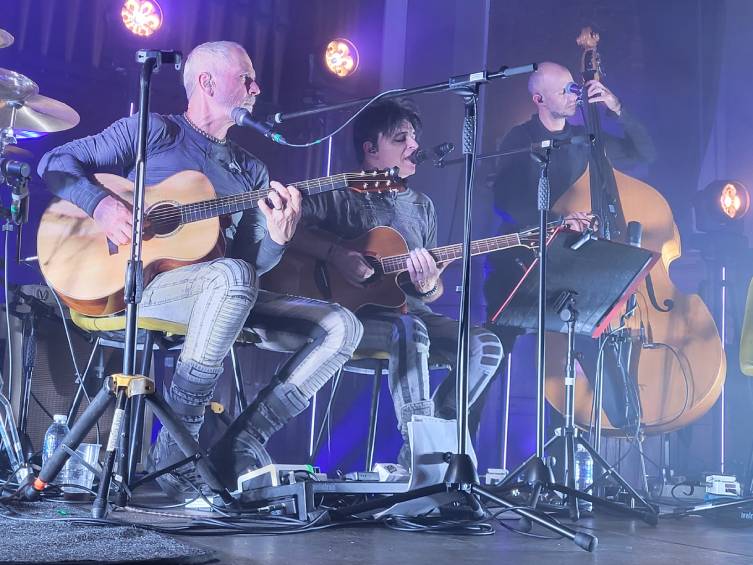
(Photo: Will Wilson)
Steve’s Guitarmory
GG: Quite right! So, let’s talk guitars then. Over the years I’ve seen you with a Hagstrom 335-style, I;ve seen a strange looking Hohner and a new kind of offset guitar that I don’t know anything about.
SH: I’ve got a Goldtop, a VOS 1957 reissue. I was a Telecaster man all the time, absolutely loved them. Then I sold all the shit guitars that I had and got this Goldtop, and it’s all I used, it’s a brilliant guitar, really lovely.
But then I had this thing where. True to form, when you look at certain genres of music, it’s PRS, ESP, lots of Les Pauls, lots of Les Paul shapes. I just didn’t want to be like that! I haven’t got hair (laughs), I’m not that guy: I want to be weird. I want to be as different as I can in any way, so I think originally I was using an Epiphone Dot 335 and I was using new electrics, new pickups, the whole thing. I really liked that, and then I think I went on to the Hagstron because I wanted the least ‘rock’ guitar you could possibly have for that situation.

(Photo: Will Wilson)
I wanted it to look unusual, so I was happy using that for a while but then I really love the offset shape. Walking past a pawnbrokers in Epsom, actually - just around the corner from the GG store - there was this Hohner hanging up there! Unique, four string Hohner as it was! It’s from the mid-80s and it had three single coils and a really strange circuit that was EQ’d to sound like humbuckers or single coils. I love the shape of it and I’ve still got it but I’ve changed it to two humbuckers, and I’ve put a Wilkinson trem on it.
I used that at the Albert Hall: it cost me £70! I probably spent about £800 getting it sorted.
GG: Steve, see even before you go on further, I love this so much: the fact that you’ve got a VOS ‘57 Les Paul Goldtop, and you left it at home and brought the seventy quid Hohner to the Albert Hall gig. I think that’s so rock ‘n’ roll, I absolutely love that! That’s one of the best things I’ve heard in months!
SH: I swear, that means a lot for some reason. I love underdogs and things, I love, like ‘right: let’s see what we can do with this’. You know, we’re gonna tour with Ministry soon and we toured with them at the start of this year. The two guitar players in Ministry have got Kempers, Wizard amps, 4x12’s, the Flying W guitars and I’m not badmouthing them because they’re A: lovely people and B: really fucking good players as well. I took a Victory Duchess, valve front end, solid state 180 watt, the H9 and the HX Stomp. We were the middle band there, and I didn’t want people to be dragging a zoo of stuff. So I kinda carried it all with me, and it worked a treat! But I’ve always been a ‘let’s see what we can get out of this’ person. That’s always been my thing. Not the shittest gear, it always has to be good, but I poured love into that guitar and I love it.
GG: And it’s unique, and it dodges the cliche, doesn’t it?
SH: Yeah, yeah. We were rehearsing in Brighton for some shows once and I was reading a magazine, I can’t remember which one it was, and it said about Trent guitars. This guy Elliott Trent,who’s based in Poole. I think he used to do real top end carpentry, and he’s an odd character, but yeah, he makes these guitars. At the time, I think he would make you a guitar from wood to finished guitar for about £900. Sure enough, he did.
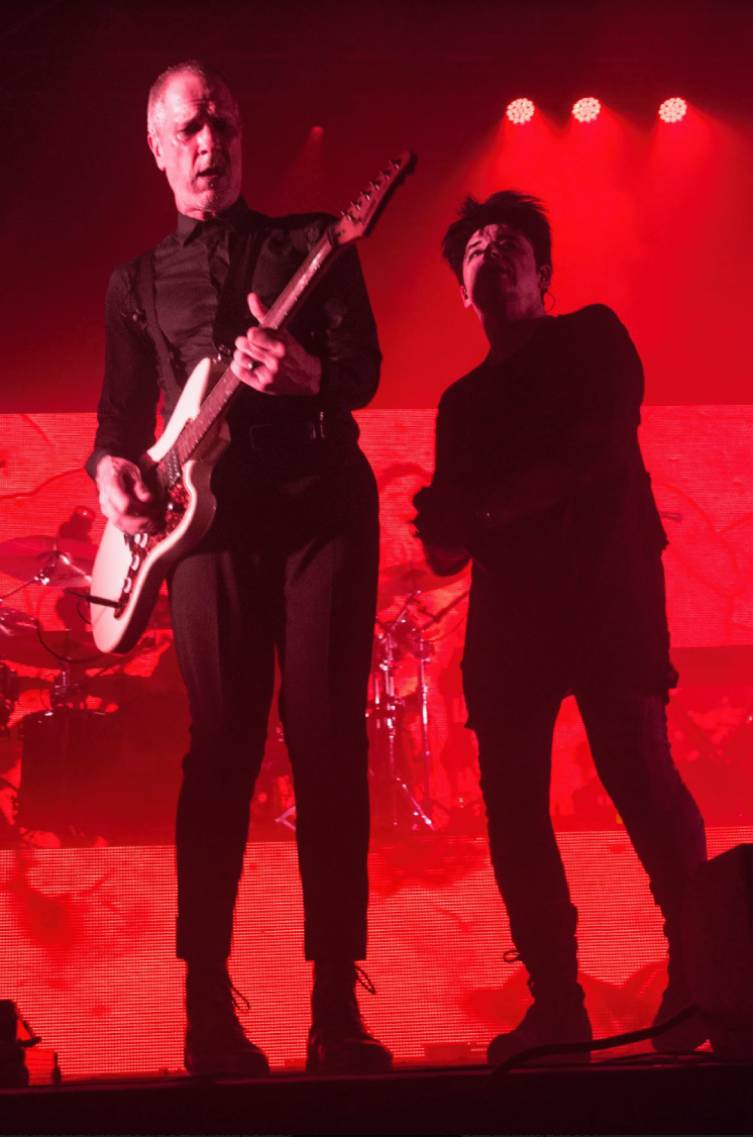
(Photo: Will Wilson)
GG: Wow! So that’s the other one I’m asking about, it’s a Trent.
SH: Yeah, I’ve got two of them now: the white one, which I had to ask him to put more meat in the neck when he was making it, because I love fat necks; and I’ve since taken it back to him. He now makes his own hardware in-house, so I’ve got him to put a tele bridge on it with three roller saddles. The white one’s got a humbucker in the back and a P90 in the front, and I’ve also got one that’s two P90s with a vibrato on it, which is just lovely.
GG: For the Numan gig, you need heavy sounds, and my own experience of P90s is that they can be noisy. Is that where noise gates and things come in handy for keeping all that at bay?
SH: Yeah, but I learned my lesson with noise gates, actually. For a hot minute there, I had it before the reverb and delay and that was disastrous, really. The gate on the HX stomp I use and yeah…the sound of a P90 though…I’d never really used them before. A P90 in the bridge with loads of dirt is ripping. Absolutely rips your face off, but not in a Strat bridge pickup way, or a Tele way: it’s really muscly and it’s very, very addictive.
GG: I need to go back to that, because one of my favourite players is Geordie Walker from Killing Joke (note: this was a week or so prior to Geordie’s passing - Ray) and he always uses that big old Gibson archtop…
SH: How does he do it? Is that a 175?
GG: It’s a 295, same build as a 175 but it’s gold, basically a big hollow thing!
SH: I know! How does he do it?
GG: It’s such a good sound, it’s everything you just described.
SH: I think half the thing is - and this is such an evolving thing for me - but heavy sounds don’t necessarily need loads of gain. The right EQ of a heavy sound is ball breaking, and that’s what he does. I used the one with the P90s for a lot of the Albert Hall gig, and take away that gain and there’s something about that internal sound that sounds heavy. It’s like being really detuned, or a baritone: a single clean note, get the sound right so you can still hear the note and it’s ‘oh!’
GG: For Gary’s stuff, is it mainly standard and Drop-D tuning?
SH: Yeah, we’ve done Drop-C as well, for a couple of tunes. Funnily enough, the two or three standard tuning ones stand out in the set because it’s so regularly Drop-D.
Touring Life, and 20 Years Knowing Gary Numan
GG: So, I suppose one of the things I’d be interested in hearing about is: you’ve known Gary for over 20 years and been on plenty of tours with him. I wonder: what is touring life like and do you have a close relationship with Gary?
SH: Just after this acoustic tour, I took my family - I’ve got three kids - and we drove up to Scotland to stay with them for a week up there. Him and Gemma are such lovely, generous people. Gemma’s mad as a hatter. But as far as touring goes, on the bus there’s 12, sometimes 13 people. You’ve got your front of house…well, you know the score: lighting, tour manager. So it’s a kind of submarine etiquette that goes on!
There’s not a whole lot of time to sit and have conversations with people, you all scuttle off to your bunks and beds. But then in the dressing room, the day does have a natural gradient to it, where everybody’s on laptops, I’ll always go out and have a big walk about wherever I am. Then it starts ramping up, the support band goes on, and people start getting changed. There’s a bit of laughter, it ramps up, ramps up, and before you know it, you’re standing at the side of the stage and you’re a gang. You look around and it’s the lads, and it’s ‘fuck me, it’s Gary Numan! (laughs) That’s that bloke off the telly!’
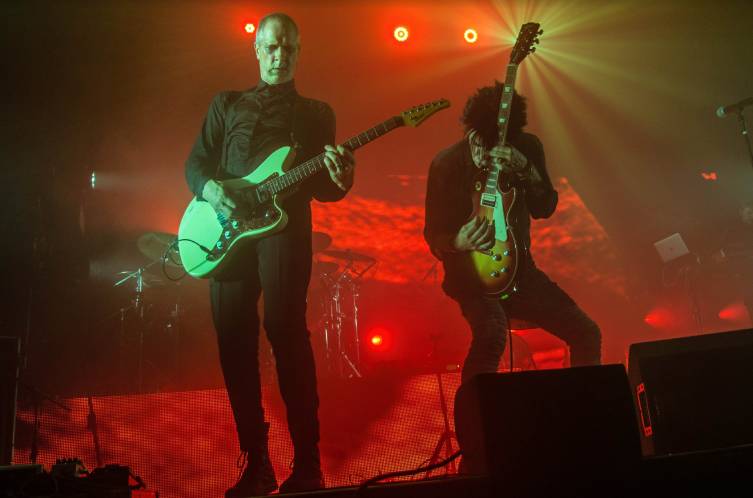
(Photo: Will Wilson)
When it comes to that situation, he’s in the gang. Leading up to that, he’s just somebody else. I think the best thing to do is just to move around as individuals. Let me ask you: have you ever been in a band for a certain amount of time, and you get really close, and there are these situations where there are people there, and you’re on stage and this gang has got to do the do. You come off and hug each other, high five, have a drink, and you do that for years and years. When that band splits up, or you go separate ways, you barely keep in touch with them, unless you join another band with them. It’s such a weird working relationship.
But yeah, Gary’s a sweetheart. When I first joined, he could be quite fiery and definitely more pronounced in the more odd areas. He’d fallen quite out of love with the industry, but over the years, moving to America and stuff, it’s come back to him and he absolutely loves it. But then, you know, you’ve got to fill a whole day up, day after day. This next tour we’re doing is 40 gigs, so you’re out there for a long time and you just do like you do in your house: you get on, you move around, you miss people, you don’t bump into them. The crescendo is the gig.
GG: Yeah, totally! Do you find that when you get back from big tours like that, do you ever get that kind of feeling at 7 o’clock when you look around and go ‘Am I not supposed to be somewhere?’
SH: The worst question is ‘what day is it?’ and that sort of thing! It’s such a weird life, you’d drive yourself mad if you tried to stay on top of it and take in everything that’s going on. It would blow your mind. For me, personally, the best thing is to let it happen, and be in it as it happens. As soon as it’s all over, you just go ‘Oh, I just want to do it again!’
Acoustic Tour
GG: Now, of all of the artists to embark on an acoustic tour, Gary Numan is perhaps not the most obvious one. I went to the Glasgow show and I was surprised by how well the material translates to acoustic, and I loved the reworkings of some tunes, in particular, Cars. That was yourself who was responsible for that, right?
SH: Yeah! When Gary said about doing the tour, we’d had a go a couple of years ago during lockdown, so things like Metal were formulated then. We worked it out, recorded it, and that was that. For the set that we did for this tour, I knew that Cars was the thing: we’d never be able to do it! I just took it as a bit of a personal challenge. Instead of (hums the famous riff) - which you could never pull off on an acoustic, it would just sound shit - for every step of the riff, I made a chord from the note. Then the melody is sung over it in real time, while the music is half time, it just took on this new life! It turned it into this sad/pretty song, you know? Then my worry was whether I could say, ‘Actually Gary, I’ve got this version of Cars!’ We rehearsed for a week up in Scotland, and it wasn’t until the Wednesday when he was like ‘We’re obviously not gonna do Cars’ and I went ‘Well, I’ve got this idea…’ He went for it!
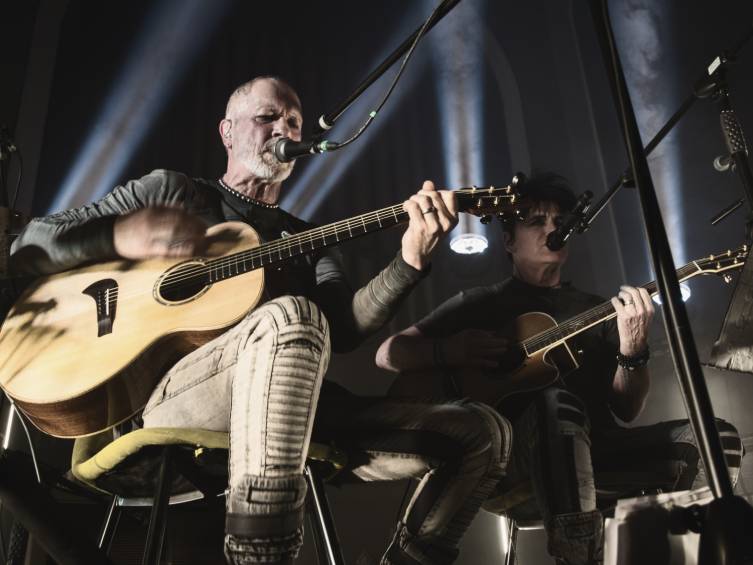
(Photo: Will Wilson)
GG: It turned out amazingly!
SH: For someone who is naturally so far out of his comfort zone with that acoustic tour, I was just really happy that he was up for it. Instead of working back from big synth lines, we started from silence. Silence is the base line, you put one thing in there, and it’s big! So that was the thinking behind a lot of the tunes.
GG: That’s a really good way of looking at a lot of work: rather than sculpting away, you’re building up.
SH: Yeah!
GG: I was trying to get eyes on what your acoustic guitar was, just for the article, and I couldn’t figure it out. What were you playing?
SH: Well, it was a Tanlgewood!
GG: Oh, cool!
SH: Yeah, they did a series - I don’t know if they still do it - that was called MasterDesign, and there’s a guy called Michael Sanden who is a master luthier. His guitars go for kind of Spot-the-ball prize money. Him and Tanglewood collaborated: he designed them, and they got them made. I know the guy at Tanglewood and got a great price on it, but never had much of an occasion to play it! A couple of times it came out for Jo the Waiter with Gary, but apart from that, I never had much reason to play it. Then when this acoustic tour came up, I thought, ‘Shit, I’d better start practising!’ About six weeks before, I was playing every day.
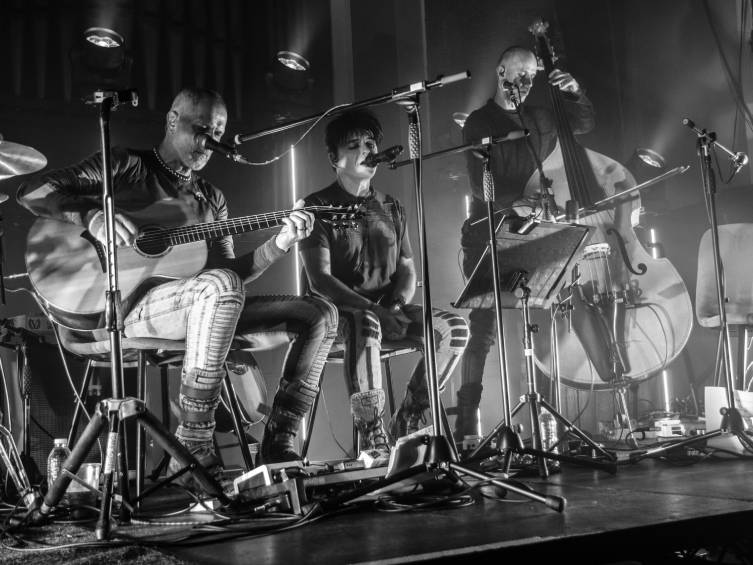
(Photo: Will Wilson)
GG: You were doing some really nice things: it sounded like artificial harmonics on one of the tunes?
SH: Yeah, just again my attempt to sort of not do…my nightmare is the guy who can do any tune with three chords that you call out round a campfire. It just makes me want to stab my eyes out, it really does! So, I wanted to treat each song as differently as possible. If I could do something like that in a tune, repeated, repeated, it would just get under people’s skin, then that was how I’d approach it, yeah.
GG: It sounded beautiful! I wonder, the setlist was so interesting: did you guys rehearse any songs that just weren’t working in acoustic mode and just had to be dropped?
SH: Most of the ones we rehearsed got into the set. There were about five songs that we could’ve done, they were doable, but they would be the live version of album filler. They just didn’t…I think if you’ve got two or three songs that have got the same kind of crescendo, or the same amount of power behind them in the studio version, then it’s difficult to make them different, you know?
GG: I know what you mean, yeah.
SH: So some that would’ve taken the wind out of others’ sails got dropped, leaving the others more powerful. None of the old ones: I think we could’ve stuck a few of the classics in there! But they were mainly ones from more recent albums.

(Photo: Will Wilson)
Theatricality and Putting on a Show
GG: Oh well, next time! One thing I wanted to touch on previously was the theatricality of the costumes and makeup. I was gonna ask if that was something you were up for and into, but then you told me that you started off with Jesus Christ Superstar, so is that theatricality just part of who you are as an artist?
SH: No, I’ve always wanted to be gay, I’m just not! (laughs) I’ve always prided myself in being a bit androgynous, but I’m just not! So,any opportunity I can get to put some makeup on and wear a skirt, I fucking love it! I used to have a Mohican, but ever since those artefacts are no longer at my disposal… Playing in front of especially a Ministry crowd, or if you do a festival, when it’s not your audience, when you go on and you look weird, these people been to work, had their dinner early, found a babysitter, driven their car, found somewhere to park, and are now standing like that: you’d better look or bring something different. The performance part of it is me trying to give value for money. I love it! I can’t stop doing that, I couldn’t stand still and do it. I love the skirts, I love when you get kind of narrow-minded, slightly bigoted people, and you can tease them with being a big bloke with a bit of lippy on, that sort of thing! I really like that!
It’s the same thing that made me use the Hohner at the Albert Hall!
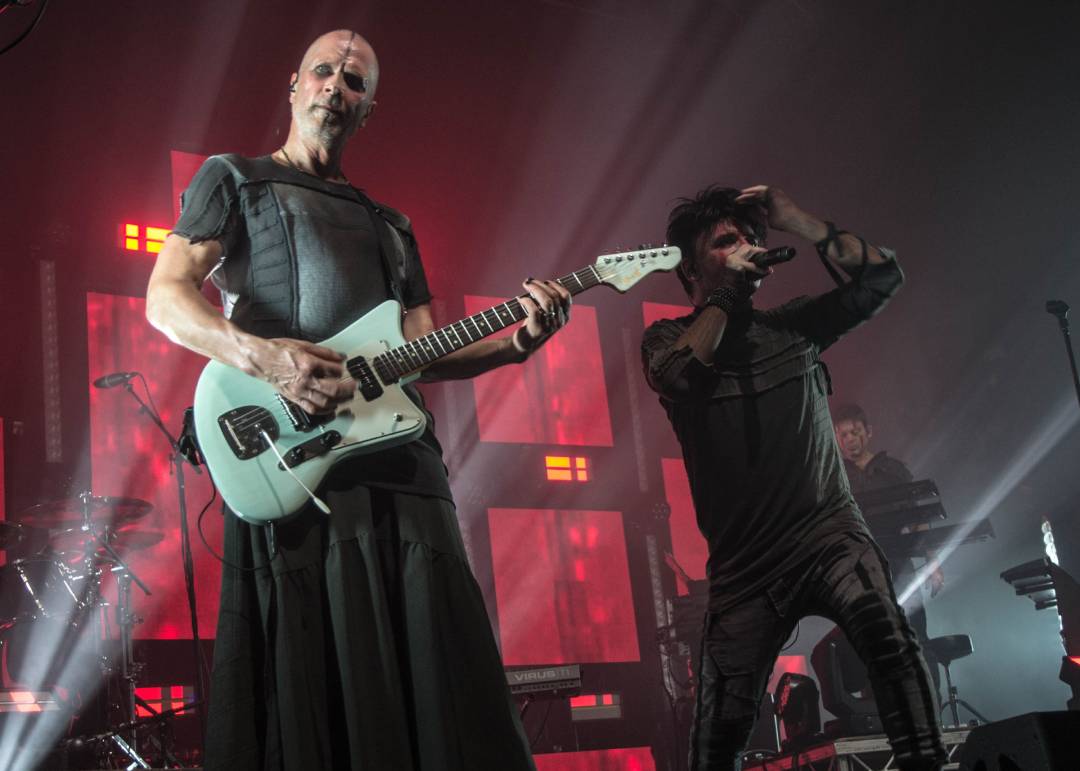
(Photo: Will Wilson)
GG: Yup!
SH: I sort of want to get on people’s nerves. It’s in us all: you seem like a lovely, peaceful bloke, but I bet there’s times when you wish you could (screws up face and holds fists in the air), you know?
GG: I think we have that in common, this desire to challenge and be a bit subversive when we can. There’s not that many instances in life where you can do that, and the stage is definitely one of those places where you can.
SH: And how weird is it, the thing you do when lots of people are looking at you? I wouldn’t dance in a nightclub: I wouldn’t even dance in front of my family! But when loads of people are looking at you, it’s like ‘what am I doing?’ It’s so free, I’ve never felt freer than I do doing that.
Steve and I spoke a little longer, about some ongoing reissue work of Gary’s mid-period records like the comeback Pure album (with updated sounds), and about his contribution to Numan’s daughter Raven’s debut record. Look out for Steve’s work on some upcoming work with Divine Shade in the new year, too.
The Numan tour with Ministry is in the middle of February, and then Gary’s new album will be finished later in the year. He’s a busy man!
My thanks go out to Steve for giving up his evening for us, to Dave Dupuis for putting us in touch, and to Will Wilson for his superlative photographs. Keep up with Gary Numan’s tour and releases by jumping onto the official Gary Numan website.
Head over to the guitarguitar Interview page for more exclusive interviews with artists such as Robin Finck, Reeves Gabrels and David Rhodes!



